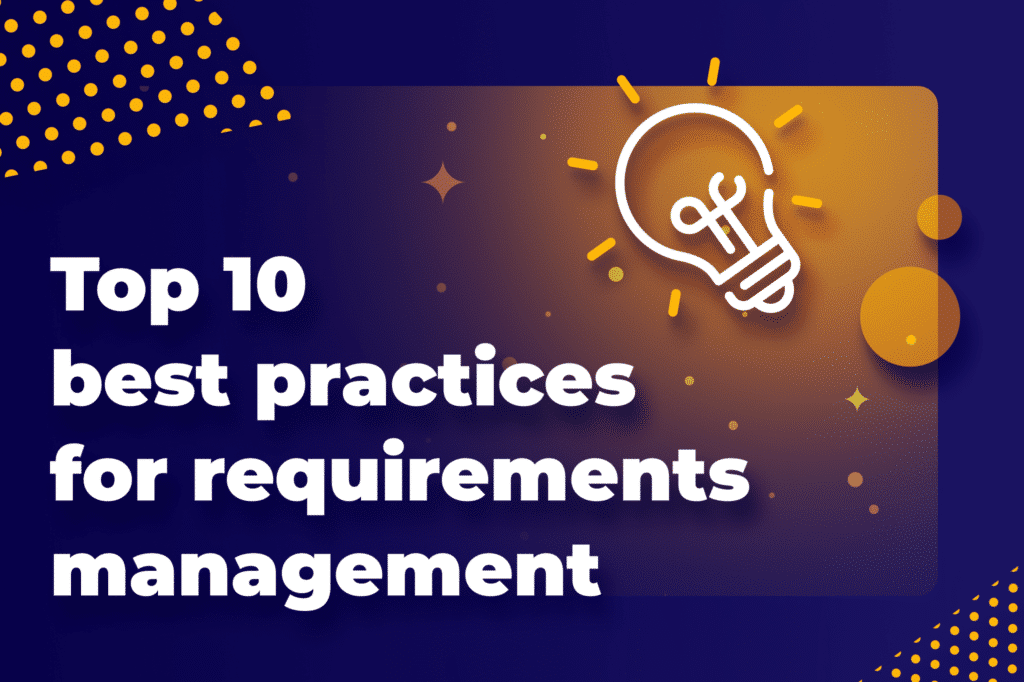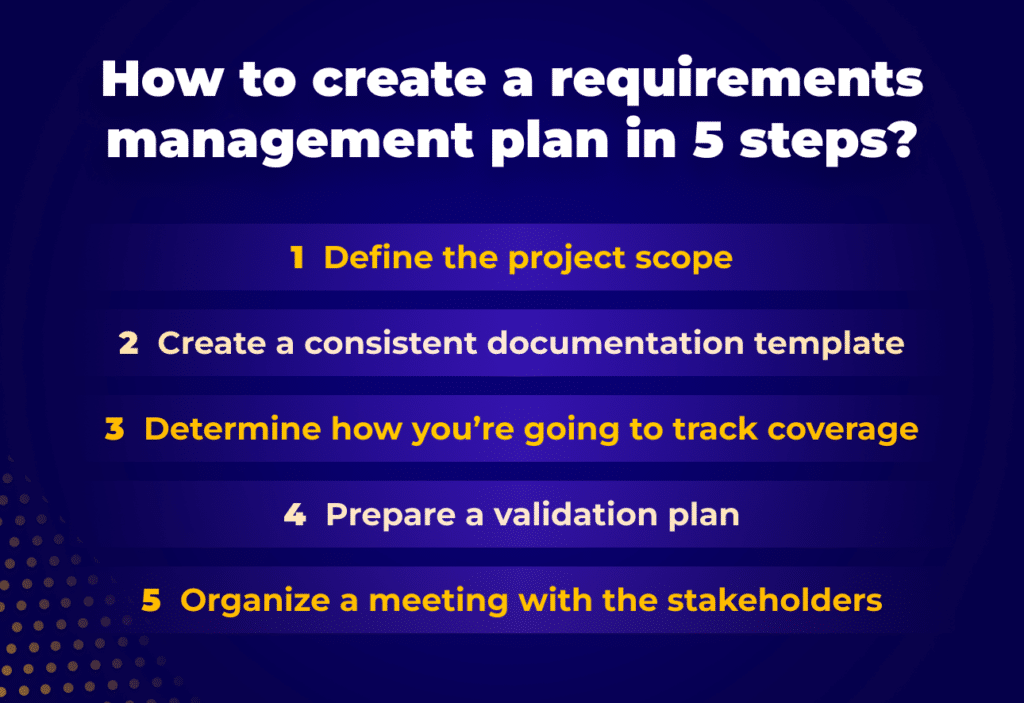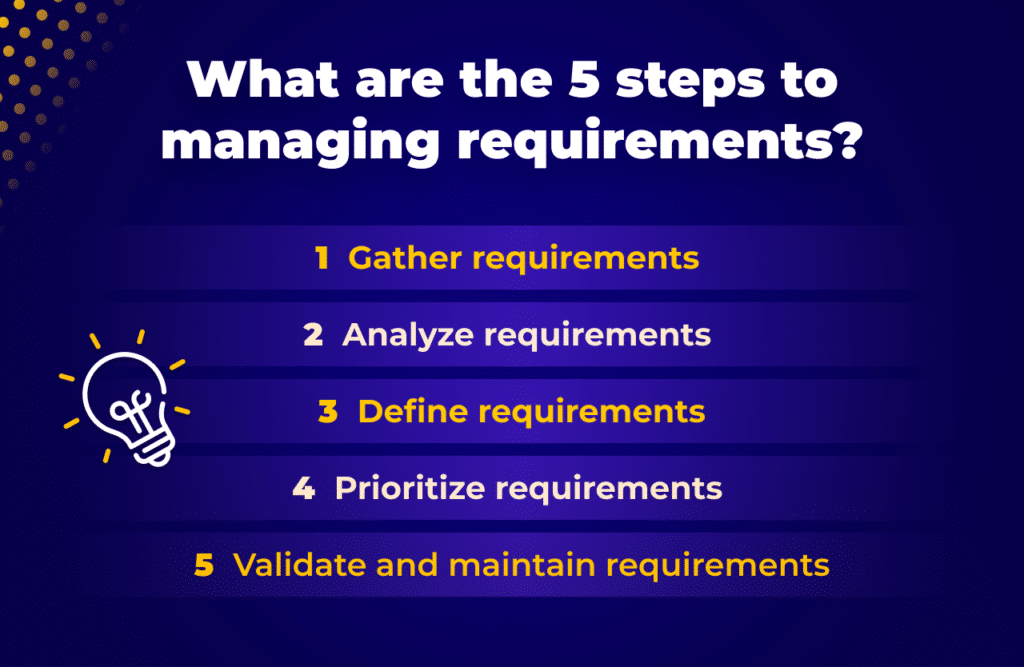Requirement management process. Top 10 best practices for requirements gathering.

This post was originally published on January 30, 2022, and has been updated for accuracy on February 22, 2024.
Have you ever been on a project where if something went wrong, people blamed each other and said the requirements weren’t clear? It’s no surprise. When you start a project without everyone understanding the requirements, it’s like trying to solve a puzzle without all the pieces.
Fortunately, we’re here to help! Let’s break down the requirement management process. We’ll see how to collect requirements to make your project smooth.
Table of contents
- What is a requirement?
- What is requirements management?
- Who is responsible for requirements management?
- What is the goal of the requirement management process?
- Benefits of requirements management
- Common challenges with requirements management
- Requirement management process planning
- What are the 5 steps to managing requirements?
- What is the requirement-gathering model?
- Top 10 best practices for requirements management
- 1. Establish clear project goals and objectives from the start
- 2. Thoroughly document every requirement activity
- 3. Promote transparency in requirements documentation
- 4. Engage with the essential stakeholders and users
- 5. Avoid making assumptions when gathering requirements
- 6. Triple-check and confirm your requirements
- 7. Master the art of active listening in requirements gathering
- 8. Emphasize business requirements over tools and technologies
- 9. Prioritize your product features
- 10. Acknowledge that perfection in requirements gathering is unattainable
What is a requirement?
In software development, a requirement is a specific need that a product or system must meet. Requirements serve as guidelines for designing, building, and evaluating a project.
Project requirements can describe what buttons to click. They can also specify what information to show and how fast things should happen. It’s like saying “Our website should load quickly, so people don’t get bored waiting.”
3 main types of requirements you need to know
You can classify requirements into different types. There are 3 of the most important that everyone should be familiar with.
- Business requirements provide the overall context and crucial goals for a project. They are often expressed in non-technical language. They focus on the broader business perspective, rather than specific technical details.
Example: A business requirement might be to increase online sales by 20% within the next year.
- User requirements are also known as functional requirements. These requirements outline the specific features of the product for the end users. They are more detailed and specific than business requirements.
Example: A user requirement could be that customers should be able to transfer funds between accounts. They want the process to take a maximum of 2 minutes.
- System requirements specify details. They describe the hardware, software, and network components that make a product work.
Example: A system requirement for a database system specifies the minimum hardware. It includes the required amount of RAM, disk space, and processor speed.
What is requirements management?
Requirements management is a systematic process. It involves identifying, documenting, and controlling changes to requirements throughout the project. It’s like making a detailed roadmap from the project’s beginning to its completion. This ensures everyone’s needs are met along the way.
Who is responsible for requirements management?
Responsibility for requirements management falls on several key roles within a project. The common roles include:
| Position | Responsibility |
| Business Analyst | – Eliciting, analyzing, and documenting requirements from stakeholders. – Ensure that the requirements align with business goals. |
| Project Manager | – Ensure that requirements are well-defined and any changes are properly managed. |
| Product Owner | – Rank features, collaborate with stakeholders, and ensure that the product meets customer expectations. |
| System Architect | – Incorporate requirements into the technical solution |
| Development Team | – Verify feasibility and alignment with the technical aspects of the project. – Responsible for implementing the requirements |
| QA Team | – Develop test cases based on the requirements and take part in validation activities – Confirm the implemented system or product meets the specified requirements |
End-users do not directly manage requirements. However, they play a crucial role by providing feedback. They help ensure that the requirements truly reflect their needs and expectations.
What is the goal of the requirement management process?
Requirements aim to make sure that the final product meets the stakeholders’ needs. The requirements management process keeps requirements clear, accurate, and manageable. This prevents scope creep, makes stakeholders happier, and helps the project develop successfully.
Benefits of requirements management
An effective requirements management process makes sure that technical solutions match business goals. Planning requirements well helps the project team communicate better. By managing requirements systematically, it’s possible to spot risks early. This, on the other hand, leads to cost savings, as it prevents rework and minimizes the impact of changes.
Moreover, managing and prioritizing requirements helps in using resources wisely. Managers can allocate resources based on importance, project timelines, and budgets. Additionally, requirements management enables traceability. It helps find the source and impact of each requirement at every stage of the project.
Common challenges with requirements management
Requirements management can be tricky. Sometimes, requirements are unclear, leading to confusion. Moreover, changes in project scope, known as scope creep, can mess up timelines and budgets.
Stakeholders might change their minds, making it hard to stick to the original plan. Incomplete requirements or bad documentation can create gaps in the final product. Prioritizing tasks can be tough, impacting deadlines.
People might resist changes, and if teams don’t work well together, it causes problems. Unrealistic expectations about timelines or budgets can be a challenge. Using outdated tools and poor change control adds more stress.
In a nutshell, these challenges need attention for a project to succeed. Clear communication and adapting to changes are key.
Requirement management process planning
The effective requirements management process helps align technical solutions with business objectives. The well-planned requirements stage facilitates communication among project team members.
How to create a requirements management plan in 5 steps?
To create a functional requirements management plan, follow the 5 key steps below.
- Define the project scope
Begin by outlining the project’s objectives. What are the specific goals the project aims to achieve? What are the boundaries within which it operates? Clearly defined project scope helps understand what requirements the team should manage.
- Create a consistent documentation template
Ensure consistency in format, terminology, and structure. Developing a standardized template supports the process of managing requirements. It also facilitates better communication among team members and stakeholders.
- Determine how you’re going to track coverage
Investigate methods for tracking requirements coverage, such as traceability matrixes or specialized tools. It is crucial to understand the coverage tracking process. This helps maintain transparency, identify gaps, and ensure all project requirements are met.
- Prepare a validation plan
How can you ensure that the project’s goals of everyone involved are met by the requirements? It’s smart to create a validation plan to review the requirements before implementation. This helps reduce the chance of mistakes and misunderstandings.
- Organize a meeting with the stakeholders
Discuss the importance of stakeholder engagement in the requirements management process. What information should be gathered and how feedback can be incorporated? Organizing a meeting with future end-users allows for clarification of expectations. It also ensures that the documented requirements align with the project’s overall goals.
What are the 5 steps to managing requirements?
The 5 steps to managing requirements are as follows:
- Gather requirements
In this stage, the team collects information from stakeholders, users, and other sources. They do this to identify and understand the needs and expectations for the project. We will talk about it further in the next section.
- Analyze requirements
Once gathered, the requirements should be analyzed to ensure clarity, completeness, and consistency. This involves identifying potential conflicts or gaps.
- Define requirements
Then, it’s time to document the analyzed requirements. This step involves creating clear statements. The statements describe the functionality, goals, and features of the product or system.
- Prioritize requirements
The team defines the requirements. Then, they prioritize them based on importance, urgency, and feasibility. This stage helps make informed decisions about resource allocation and project planning.
- Validate and maintain requirements
The final step involves validating the requirements. It ensures they meet the stakeholders’ needs. In addition, ongoing maintenance is crucial. It accommodates changes or new insights that may arise throughout the project lifecycle.
What is the requirement-gathering model?
The requirement-gathering model is an approach to document and understand the needs of stakeholders for a project. Different projects may use various methods based on their specific characteristics and requirements.
What is the best method for gathering requirements?
There is no one-size-fits-all answer to the best method for gathering requirements. Different methods may be more effective in different situations. Here are some commonly used methods for gathering requirements:
- Interviews. Direct conversations with stakeholders. They are used to getting to know their needs, preferences, and expectations.
- Surveys. Distribute questionnaires to the stakeholders to collect information on their requirements.
- Workshops. Collaborative sessions where stakeholders actively participate in discussions to identify and prioritize requirements.
- Observation. Observing users’ behaviors in their natural work environment can help uncover implicit requirements.
- Prototyping. Creating a prototype of the system to get feedback and adjust requirements.
- Document Analysis. Reviewing existing documentation to extract relevant information about requirements.
- Brainstorming. Engaging stakeholders in a creative discussion to generate ideas.
- Use Cases and User Stories. Describing specific scenarios or user-focused narratives to capture functional and non-functional requirements.
- Joint Application Development (JAD). Organizing workshops where stakeholders collaborate with development teams to define requirements collectively.
- Feedback and Iteration. Establishing a continuous feedback loop, where stakeholders regularly review evolving requirements.
What are the 5 stages of requirement gathering?
The exact number of stages may vary depending on the framework used. Here are five common stages:
- Assign roles
Identify and assign specific roles to team members involved in the requirement-gathering process. This could include a requirements analyst, project manager, stakeholders, and subject matter experts. Clearly define and communicate the responsibilities.
- Interview stakeholders
Select appropriate methods (interviews, surveys, workshops, etc.) and create a schedule. Interact with stakeholders to learn about their needs, preferences, and expectations. The goal is to uncover both explicit and implicit requirements.
- List assumptions
The analysis stage involves reviewing, organizing, and documenting the gathered information. This includes resolving conflicts and ensuring that the requirements are consistent and practical. The result is a clear and structured set of documented requirements.
- Get approval
Make sure you have formal approval from stakeholders. This ensures a common understanding and commitment to the agreed-upon requirements.
- Monitor progress
Monitor the progress of the requirement-gathering process. This involves tracking activities. It ensures timelines are met and addresses any issues that may arise.
Top 10 best practices for requirements management
1. Establish clear project goals and objectives from the start
Start by clearly defining what you want to achieve with your project. Having well-defined goals from the beginning guides all your efforts.
2. Thoroughly document every requirement activity
Write down every detail about what the project needs. This documentation ensures everyone knows what to do and what’s expected.
3. Promote transparency in requirements documentation
Share your requirements openly with everyone involved. Transparency prevents confusion and ensures everyone is on the same page.
4. Engage with the essential stakeholders and users
Talk to the people who matter the most—your stakeholders and users. Their point of view is invaluable for a successful project.
5. Avoid making assumptions when gathering requirements
Don’t assume you know what someone needs. Ask questions and get the facts straight to avoid mistakes down the line.
6. Triple-check and confirm your requirements
Always go the extra mile to check and confirm your requirements. Mistakes can lead to problems, so triple-checking is a worthwhile effort.
7. Master the art of active listening in requirements gathering
When gathering requirements, practice active listening. Truly understanding what people are saying ensures accurate and meaningful requirements.
8. Emphasize business requirements over tools and technologies
Keep your focus on solving business problems. Don’t get caught up in fancy tools and technologies. Understand the real needs.
9. Prioritize your product features
Not all features are equally important. Set up priorities to ensure that the team will address the most crucial aspects first.
10. Acknowledge that perfection in requirements gathering is unattainable
Understand that perfection in requirements gathering is impossible. Aim for the best, but be ready to adapt and improve as needed.
Frequently Asked Questions
-
Are there requirement-gathering tools available?
Several tools can assist in the process. Some of the most popular include:
Confluence for requirements management
Confluence, often integrated with Jira, is a collaboration tool. It helps teams create, share, and work on documents together. Confluence is useful for designing and maintaining a centralized place for project requirements.
Jira for requirements management
Jira is a popular project management tool that includes features for requirements gathering. If your team already uses Jira, it’s a good idea to try it out as a requirements management software.
You can customize your Jira instance with dedicated apps. One of them is Requirements and Test Management for Jira (RTM).
Tree-structured view
Requirements and Test Management support gathering requirements along with writing test cases. It offers a transparent tree-like view for requirements. RTM seamlessly integrates with Jira and enables linking to Epics and user stories. The familiar interface makes it easy to start working without additional training.
Real-time reports
Requirements and Test Management for Jira has built-in reporting features. The two of them that help with requirements management are:
- Traceability Matrix allows to track relations between any two baselined types of requirements. Using JQL, we can define which issue types we’d like to see on the X and Y axes of our matrix.
- Requirement Coverage shows if testing objects cover requirements. We can filter displayed elements or choose only covered or uncovered ones.
-
What are the 7 steps in the requirement engineering process?
The specific steps may vary depending on the methodology used. Let’s break down the most popular ones:
- Elicitation – talk to people. Ask people what they need and want for the project. This includes talking to users, customers, and others involved.
- Analysis – sort and understand. Look at what people say and make sense of it. Check if everything makes sense and if there are any conflicts.
- Specification – write it down. Write clear and easy-to-understand documents that explain what the project needs to do. This includes describing how it should work and any specific requirements.
- Validation – check with stakeholders. Double-check to make sure the requirements match their needs. This helps catch any misunderstandings early on.
- Verification – make sure it fits. Confirm that the requirements fit with the overall goals of the project. Check if they follow any rules or standards.
- Management and communication – keep everyone updated. Set up a way to manage changes to the requirements. Make sure everyone knows about any updates or changes so they can work accordingly.
- Documentation and maintenance – write it down and keep it updated. Document everything about the requirements. Keep these documents up to date throughout the project, especially if things change.
-
How do you structure requirements gathering?
Structured requirements gathering starts with defining the product goal. Then, the team needs to identify stakeholders and assign roles. The next step is conducting interviews or workshops. At this point, remember to document your requirements. When the requirements are ready, make sure you get the formal approval. Remember to track progress and note your conclusions. This approach ensures an organized process for effective requirements gathering.
-
What is the requirement management process APM?
When it comes to the Association for Project Management (APM), requirements management is the process of capturing, assessing, and justifying stakeholders’ wants and needs to satisfy an identified need. Comprehensive and measurable requirements are critical to the success of a change initiative. You can read more on the topic by going to the APM’s website.
-
How can AI help with requirements management?
AI makes it easier to document project needs. It pulls information from different places. It understands everyday language, turning user inputs into clear requirements. It can figure out what tasks are most important based on things like business impact. By looking at past data, AI spots potential issues, helping teams plan better.
What’s more, AI can do repetitive tasks automatically. It can help with updating documents and tracking changes. This saves time and reduces mistakes. It predicts possible changes to project requirements, helping teams adjust plans early on. Automated tools show how changes to one requirement might affect others. It’s also useful in automated testing. You can use it to check if the final product matches what was initially required.
In short, AI makes managing project requirements smoother. It brings useful insights for a successful project.
Key takeaway
To ensure the project goes well, it is crucial to manage requirements effectively. Teams can communicate better and prevent scope creep by following good tips. They can also make sure the technical solutions match the business objectives.
In summary, there are 4 main steps to manage requirements:
1. Get the information.
2. Look at it closely.
3. Write it down clearly.
4. Decide what’s most important.
Remember to keep checking and updating the requirements. There are helpful tools like Confluence, Jira, and AI that make things easier. Adopting best practices streamlines requirements gathering and increases the project’s chances of success.




